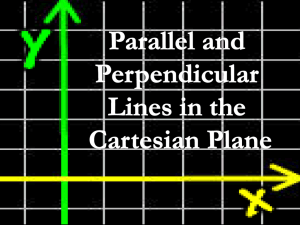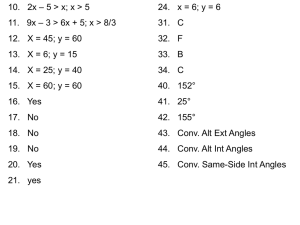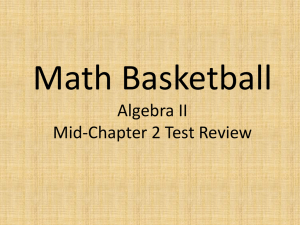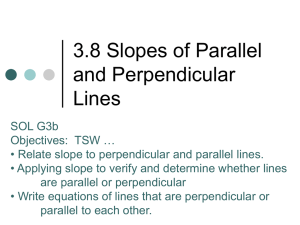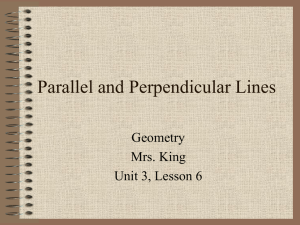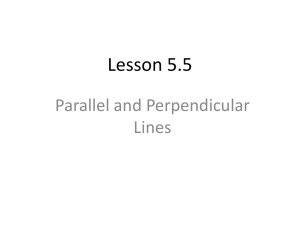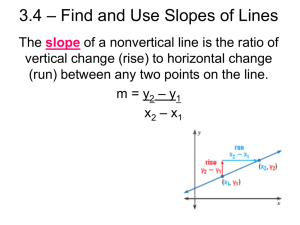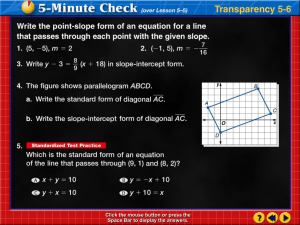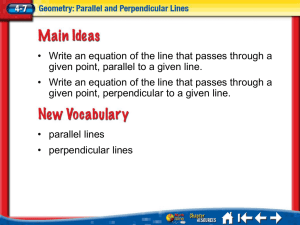6.7 Prll _ Prpndclr Lines
advertisement
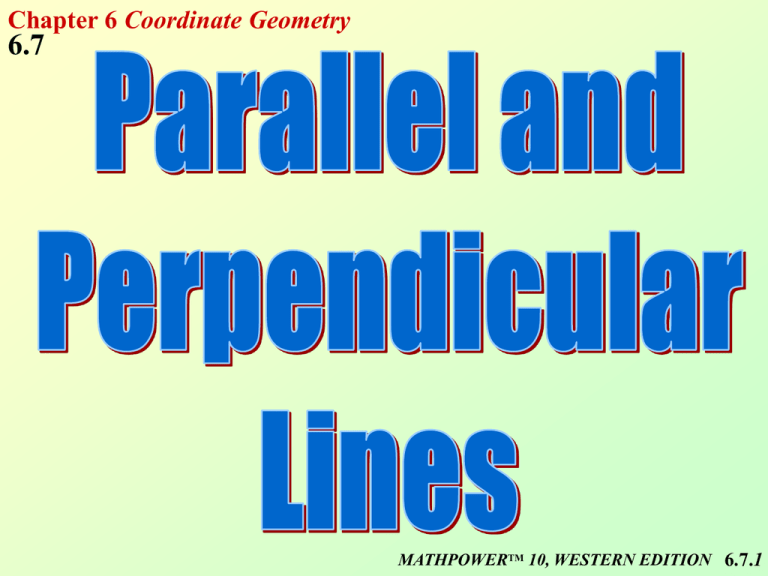
Chapter 6 Coordinate Geometry 6.7 MATHPOWERTM 10, WESTERN EDITION 6.7.1 Parallel Lines m AB 50 0 3 m AB 5 3 m CD m CD 0 5 B(0, 5) 30 5 3 D(3, 0) A(-3, 0) If the slopes of two lines are equal, the lines are parallel. If two lines are parallel, their slopes are equal. C(0, -5) AB is parallel to CD. 6.7.2 Verifying Parallel Lines Show that the line segment AB with endpoints A(2, 3) and B(6, 5) is parallel to the line segment CD with endpoints C(-1, 4) and D(3, 6). y 2 y1 m x2 x1 m AB m AB 5 3 6 2 1 2 m CD m CD 64 3 1 1 2 Since the slopes are equal, the line segments are parallel. 6.7.3 Using Parallel Slopes to Find k The following are slopes of parallel lines. Find the value of k. a) 2 3 2 4 , k 3 c) -k 5 k 5 b) 4 k , 3 2 -2k = 15 k = 15 2 2 , k 5 d) 2 5 1 2k = 12 k=6 3 -1 k -k 3 k 3 -1k = 10 k = -10 2 , -2 7 2 -7k = -6 7 k= 6 7 6.7.4 Perpendicular Lines m AB m AB 2 2 4 2 2 3 m CD 4 2 1 3 m CD D(-1, 4) B(4, 2) 3 2 If the slopes of two lines are negative reciprocals, the lines are perpendicular. A(-2, -2) C(3, -2) AB is perpendicular to CD. If two lines are perpendicular, their slopes are negative reciprocals. 6.7.5 Perpendicular Line Segments Show that the line segment AB with endpoints A(0, 2) and B(-3, -4) is perpendicular to the line segment CD with endpoints C(2, -4) and D(-8, 1). m m AB 4 2 3 0 m AB 2 y 2 y1 x2 x1 m CD 1 4 8 2 m CD 1 2 The slopes are equal so line segments are perpendicular. 6.7.6 Using Perpendicular Slopes to Find k The following are slopes of perpendicular lines. Find the value of k. a) 2 , 3 2 4 b) k c) k -3k = 8 1 4 k = 5 3 2 k 2 , k 3 k= 10 3 k 3 k= 2 5 -2 , 3 -3k = -10 -5k = -2 k 2 -k d) 5 5 8 3 , 2 5 3 -k -1 7 7 2 -2k = 21 k = 21 2 6.7.7 Parallel and Perpendicular Lines Given the following equations of lines, determine which are parallel and which are perpendicular. A) 3x + 4y - 24 = 0 B) 3x - 4y + 10 = 0 -4y = -3x - 10 4y = -3x + 24 Slope = 3 y = 3 4 x+6 Slope = 4 y= 3 3 4 x + 5/2 4 C) 4x + 3y - 16 = 0 D) 6x + 8y + 15 = 0 8y = -6x - 15 3y = -4x + 16 Slope = 4 3 y 4 3 x 16 3 y Slope = 3 3 4 x 15 8 4 Lines A and D have the same slope, so they are parallel. Lines B and C have negative reciprocal slopes, so they are 6.7.8 perpendicular. Writing the Equation of a Line Find the equation of the line through the point A(-1, 5) and parallel to 3x - 4y + 16 = 0. Find the slope. 3x - 4y + 16 = 0 -4y = - 3x - 16 3 y= x+4 4 Slope = 3 y - y1 = m(x - x1) y-5= 3 4 (x - -1) 4y - 20 = 3(x + 1) 4y - 20 = 3x + 3 0 = 3x - 4y + 23 4 3x - 4y + 23 = 0 6.7.9 Writing the Equation of a Line Find the equation of the line through the point A(-1, 5) and perpendicular to 3x - 4y + 16 = 0. Find the slope. 3x - 4y + 16 = 0 -4y = -3x - 16 3 y= x+4 4 Slope = 3 4 Therefore, use the slope 4 . y - y1 = m(x - x1) y-5= 4 3 (x - -1) 3y - 15 = -4(x + 1) 3y - 15 = -4x - 4 4x + 3y - 11 = 0 4x + 3y - 11 = 0 3 6.7.10 Writing the Equation of a Line Determine the equation of the line parallel to 3x + 6y - 9 = 0 and with the same y-intercept as 4x + 4y - 16 = 0. 3x + 6y - 9 = 0 6y = -3x + 9 y 1 2 x 3 2 The slope . is 1 2 . 4x + 4y - 16 = 0 For the y-intercept, x = 0: 4(0) + 4y - 16 = 0 4y = 16 y=4 A point is (0, 4). y - y1 = m(x - x1) y-4= 1 2 (x - 0) 2y - 8 = -1x x + 2y - 8 = 0 6.7.11 Writing the Equation of a Line Determine the equation of the line that is perpendicular to 3x + 6y - 9 = 0 and has the same x-intercept as 4x + 4y - 16 = 0. 3x + 6y - 9 = 0 4x + 4y - 16 = 0 6y = -3x + 9 For the x-intercept, y = 0: y 1 2 x 3 2 The slope is 2. y - y1 = m(x - x1) y - 0 = 2(x - 4) y = 2x - 8 0 = 2x - y - 8 4x + 4(0)- 16 = 0 4x = 16 x=4 A point is (4, 0). The equation of the line is 2x - y - 8 = 0. 6.7.12 Writing the Equation of a Line Determine the equation of each of the following lines. A) perpendicular to 5x - y - 1 = 0 and passing through (4, -2) x + 5y + 6 = 0 B) perpendicular to 2x - y - 3 = 0 and intersects the y-axis at -2 x + 2y + 4 = 0 C) parallel to 2x + 5y + 10 = 0 and same x-intercept as 4x + 8 = 0 2x + 5y + 4 = 0 D) passing through the point (3, 6) and parallel to the x-axis y = 6 or y - 6 = 0 E) passing through the y-intercept of 6x + 5y + 25 = 0 and parallel to 4x - 3y + 9 = 0 4x - 3y - 15 = 0 F) passing through the x-intercept of 6x + 5y + 30 = 0 and perpendicular to 4x - 3y + 9 = 0 3x + 4y + 15 = 0 6.7.13 Suggested Questions: Pages 294 and 295 1 - 25 odd, 27ace, 28 - 42 even, 44 - 50 6.7.14
